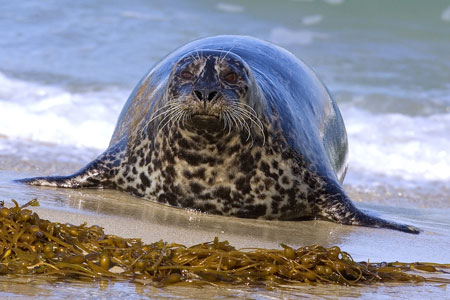

|
Harbor Seal (Phoca vitulina) Description: Harbor seals are brown, tan, or gray, with distinctive V-shaped nostrils. They have a rounded, spindle-shaped body. Spots or rings are visible on the dorsal surface and much more sparse on the underside. The body and flippers are short, with a proportionately large, rounded head. An adult can attain a length of 1.85 meters (6.1 ft) and a mass of 132 kilograms (290 lbs). Females are generally smaller than males.
The harbor seal is the only pinniped that breeds along Puget Sound. Pinnipeds spend part of their lives in the water but depend on land to give birth and raise young. The term "pinniped" comes from the Latin word "pinna" meaning winged and "ped" meaning foot. (WA Department of Ecology) Diet: Harbor Seals are carnivorous (meat eater). They primarily prey upon fish such as menhaden, anchovy, sea bass, herring, cod, whiting and flatfish. They also feed on shrimp, mollusks and squid. Harbor seals do not chew their food; they either tear it into chunks or swallow it whole. Harbor seals are eaten by great white sharks and killer whales.
Behavior:
Harbor seals are curious but shy animals that prefer quiet, unpopulated areas. Seals like to "haul out" on protected beaches, spits, bars, rocks and log rafts to bask in the sun and sleep. At the slightest sign of danger they will slip back into the water and swim away. Harbor seals often haul out at low tide to rest, digest food, give birth, or nurse their young. Aggression is shown by snorting, growling, waving a front flipper, and head-thrusting - a sharp, rapid retraction of the neck. Reproduction: Males fight over mates underwater. Females mate with the strongest males, then bear single pups, which they care for alone. The gestation period lasts between 9 and 11 months. Pups are able to swim and dive within hours of birth, and they grow quickly on their mothers' milk. The pups nurse for three to six weeks. Conservation Status: The U.S. Marine Mammal Protection Act of 1972 made it illegal to hunt or harass any marine mammal in U.S. waters. In Canada, Norway, and the United Kingdom, it is legal to shoot harbor seals to protect fisheries or fish farms. Many fish species eaten by harbor seals are also commercially fished, and the seals often become entangled and drown in fishing nets and gear (Animal Diversity Web).
Did you know?

Harbor seal photo by Natures Pics More information: Stranded harbor-seal pup cute, but don't touch - The Seattle Times "And remember, said stranding coordinator Jessie Huggins, next time you see that cuddly, helpless-looking seal pup on the beach, walk away and call the Northwest Marine Mammal Stranding Network Hotline at 800-853-1964".
|
Animal silhouettes available to purchase »
Home | About Us | How to Participate | Biodiversity Modules | Projects | Maps | News | Resources